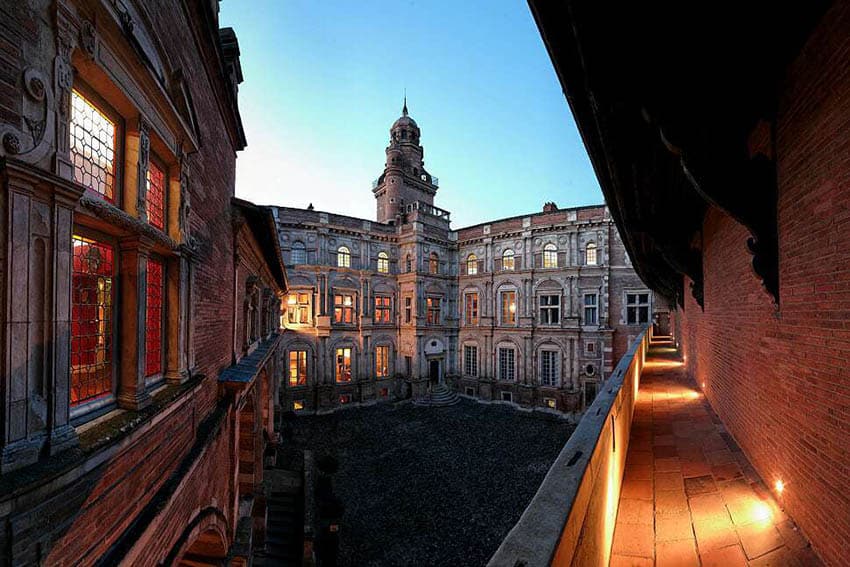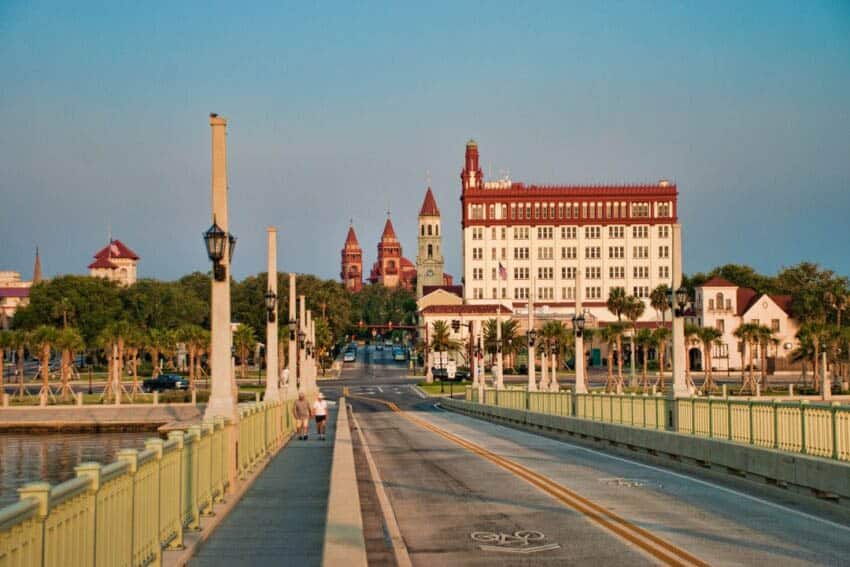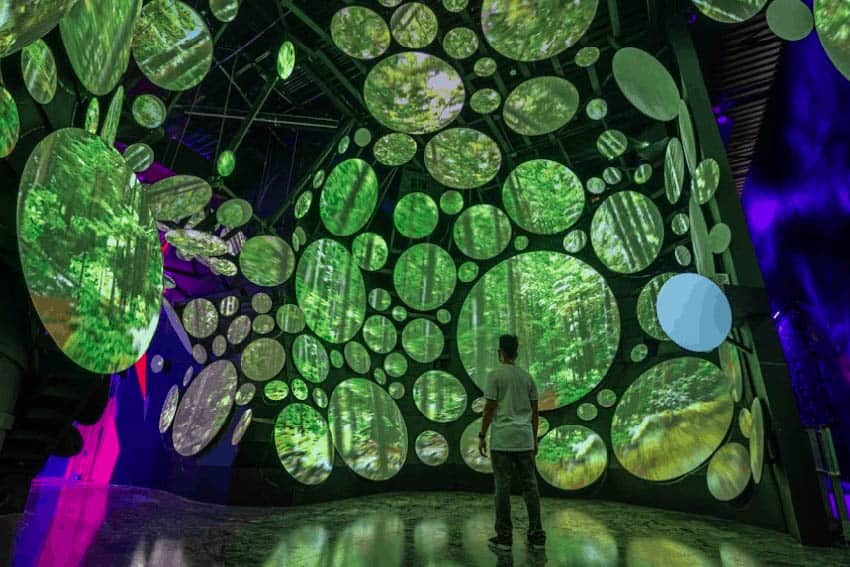
By Ginger Warder

On my first trip to Germany more than 10 years ago, I fell in love with Bavaria: the romantic castles and onion-domed churches, the fabulous food and frothy beers, and the cable cars that take you into the clouds and the snowy Alps above them.
My best friend and I rented a car in Munich and hit the autobahn for a driving tour that proved to be an incredible adventure. At our first gas stop, we purchased a popular souvenir, a stuffed cow in Alpine garb that yodeled when you pressed his tummy.
We named him “Ausgang” after the exit signs on the highways, and he sat on our dashboard throughout the trip, yodeling as we crossed one mountain after another.
So when I was invited to visit upper Bavaria, I thought it only fitting that Ausgang should go along for a visit to his native land.
More Than Two Million Swans Sold in Ruhpolding
Our tour began in Ruhpolding, one of Europe’s most popular year-round resorts located near the Austrian border (45 kilometers from Salzburg), and in the purple section of the Via Alpina, an international trail through the Alps that traverses eight countries. Ruhpolding is known as a wellness resort, and also as the home of the Biathlon World Cup.
Our guide, Herbert Ringsgwandl, a former competitive skier, welcomed us with a lunch at a historic restaurant in an old farmhouse called “Windbeutelgräfin”. I had my favorite Bavarian meal, Schweinebraten (pork roast) with a large helping of kanoodle (dumplings), but dessert was the real show-stopper.

Herr Jochen Grill, the owner, is out to break McDonald’s sales record, but he’s going to do it with his world-famous “swans”. Elaborate, multi-layered profiteroles stuffed with ice cream are shaped like swans, and each comes with a paper bird that tells you which number swan you have received.
Mine was 2,185,000, so with more than two million swans and counting, Grill is well on his way to a world record, and every mouthful of his decadent swan was worth counting. If you can eat three of the dessert birds, Grill will give you a free one.
To walk off our huge lunch, Rupert took us on a tour of the resort’s leisure complex which includes Germany’s first indoor wave pool, a spa complex, tennis and golf facilities, hiking and biking trails, a Nordic walking center (recreational walking with ski poles which is hugely popular in Europe), and an outdoor amphitheatre for special concerts and programs.
Accommodations range from upscale hotels to private houses, with prices to fit any budget. We stayed at a charming traditional chalet-style hotel called The Steinbach within walking distance of the small village, which has about 7300 permanent residents.

During our free time in the afternoon, I strolled up and down the main street, browsing in the grocery store and gift shops, stopping for a cold mug at one of the outdoor beer gardens.
That evening was a real “knee-slapper” (literally) as Rupert took us for a tour of the Wood Cutter’s Museum, followed by a private dinner in one of the log cabins with entertainment by a troupe of musicians and folk dancers.
They taught us how to do the “schuhplattle”, which literally means to slap your shoes, although a lot of knee-slapping is involved as well. Accompanied by an accordion player, the dance is harder than it appears, but after several rounds of schnaaps, we were enthusiastic, if not coordinated.
We had a lovely buffet dinner and several more good German beers with our new friends before heading back to our hotel.
Vertical Vacation: Ascending Mount Rauschberg
The next morning we headed up to the peak of Mount Rauschberg by cable car (15 Euros round trip) for a stunning panoramic view of the Alps. This is part of the German Alpine Road whose 450 km trail passes by 25 castles and 21 lakes, with incredible panoramic mountain views every step of the way.

Our cable car was packed with locals and their dogs (who don’t seem to mind hanging from a box in the sky) and several paragliders who had to stick their gear out of the window to get it onboard. These folks are truly nuts… they walk off the top of mountains like this 1671-metre behemoth without a thought!
When we disembarked at the top, we hiked for about an hour uphill to see the sculpture called Adam’s Hand, although one of our party had to turn back due to severe altitude sickness.
One of the coolest things on Rauschberg is a restaurant with bunk bed accommodations (a bargain at 15 Euros a night or 25 Euros including dinner and breakfast). There’s also a Kinderland resort with playgrounds, trampolines, and child-sized Alpine play houses on the grounds.
We had the option of hiking down, but it’s a difficult trail with a lot of loose stone, so I rode down in comfort in the cable car with my new canine friends.
Lake Chiemsee and King Ludwig’s Palace
That afternoon, we headed to Bavaria’s largest lake, Chiemsee (about 25 km from Ruhpolding) to take the excursion boat to Herrensel (Men’s Island) where King Ludwig II built his homage to the Sun King.

Begun in 1873 and modeled after Versailles, Herren-Chiemsee has its own hall of mirrors, but only 20 rooms of Ludwig’s over-the-top palace were completed before his death two years later. (You may know that Ludwig was the creator of Neuschwanstein Castle, the inspiration for Disney’s famous turrets).
After disembarking from the boat, you’re picked up by a horse-drawn cart and transported to the circular drive in front of the castle. Guided tours leave every twenty minutes, and no photographs are allowed inside the palace.
The rooms that Ludwig did complete are impressive, with half-ton Lobmeyer crystal chandeliers, ornate furnishings, and ingenious design elements like a dining table that lowers by pulley through the floor to the kitchen below to be set up with the food and then is hauled back up to the dining room.
Ludwig was the original Bavarian “home-o-sexual” (double entendre intended… there has always been speculation about his sexual orientation, his long relationship with Richard Wagner, and his mysterious death). A priceless Meissen chandelier that Ludwig commissioned for his dining room is unique, as the King insisted that the plans and molds be destroyed so it would be the only one of its kind.

After touring the palace, we boated back to the main marina at Lake Chiemsee and had a lovely outdoor dinner on the terrace of the Hotel Luitpold. It was a relaxing end to a wonderful day, watching the steamers and sightseeing boats returning to dock while the sun set on the lake.
Hiking to the Alm
The sound of cow bells ebbed and flowed with the breeze, as we hiked for two hours up the gently curving hill to the Roethelmoos Alm. Rolling green meadows with grazing cows, crates of rabbits and a miniature pony surrounded the small mountain hut which is well known for its cheese-making.
The picnic tables in the front and to the side were filled with hikers like ourselves, breaking for a mid-morning snack of Brotzeit, platters of homemade butter, cheeses, pickles, breads and the tasty German ham called speck.
The family calico cat sat quietly at my feet under the table waiting to retrieve the bits of ham I snuck to her, as we piled on the carbs and protein for the next leg of our hike.
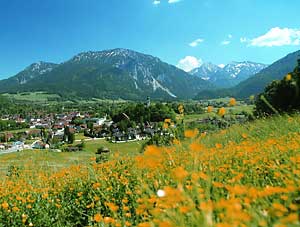
Bad Reichenhall, the BürgerBräu and Berchtesgaden
I was not really looking forward to our tour of the Eagles’ Nest. To me, Hitler was the essence of evil and to preserve anything related to the man or his regime, is to elevate him to a status he does not deserve.
Many of the locals in the area would agree with me, and in fact, most of Obersalzberg was destroyed after the war, but the Eagles’ Nest was left to become a tourist attraction.
Although busloads of tourists make the trek up the steep northwest face of the Kehlstein mountain daily, it’s becoming increasingly evident that not destroying Hitler’s aerie may have been a big mistake, because along with the tourists, have come the Neo-Nazi youth from around the world. For them, this site is a shrine rather than an abomination, and they leave tributes in the forests surrounding it.
I found it creepy to tour the underground bunkers that once were lavishly furnished apartments for Hitler’s top aides. The mustached maniac had created this hollowed-out mountain fortress as a last bastion of defense, and it was even creepier to ride the elevator up to the Eagles’ Nest, knowing that he had once ridden in that same conveyance.
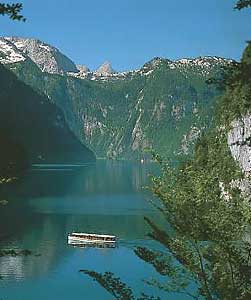
Built by Martin Bormann as a 50th birthday gift for Hitler, the Eagles’ Nest was a teahouse for diplomats, and a private sunbathing terrace for Eva Braun, but was rarely enjoyed by Adolf, who was afraid of heights.
From the terrace, you can see Austria on one side and Lake Konigsee on the other, and I was relieved when we headed down to the lake for a boat ride to the Chapel of St. Bartholomew, founded in 1134.
The marina at Lake Konigsee reminded me of Coney Island, with stalls of snack food and summer souvenirs surrounding the docks. On our ride out to the island, a musician played a flugelhorn (trumpet) whose melancholy notes echoed around the lake, bouncing off the rocky cliffs.
From the lake, the Eagles’ Nest is in clear view, but the relaxing excursion boat was a great antidote to the gruesome sightseeing.
A Bed and Breakfast and Brewery
That evening, we headed for Bad Reichenhall to visit the local brewery, Unser BürgerBräu. Actually, the BürgerBräu is a B & B & B: a brewery, and a bed and breakfast. Manager Werner Kunert gave us a tour of the brewery and some tips on German beer-making, some of which date back to the brewery’s beginnings in 1633.
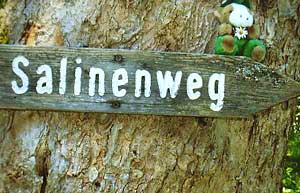
After a hearty dinner of potato soup, wiener schnitzel, and of course, a sample of the local brews, Werner invited us to join him at the village Oktoberfest tent.
An eight-piece band played for regionally-costumed folk dancers and giant steins of cold beer washed down huge pretzels and wursts.
It was one of the highlights of our trip, and I was sorry we couldn’t stay longer at the festival or at the B&B&B with our genial host. If you’re planning a visit to the Berchtesgaden/Bad Reichenhall area, what could be better than the warm hospitality, home-style food, and freshly-brewed beer?
Ausgang and I are already planning our next trip to his homeland, this time to enjoy the spirit of Christmas at the Bavarian village Christmas markets. Make a platter of Brotzeit, grab a cold one, and start planning your visit to one of the most beautiful sections of the German Alps… Pröst!
ADDITIONAL RESOURCES:
- Back to the Future in Knoxville, Tennessee - December 14, 2023
- Santee Cooper Country, South Carolina for Fishing and Fun - March 31, 2022
- Connemara, Ireland’s West Coast - April 10, 2020


